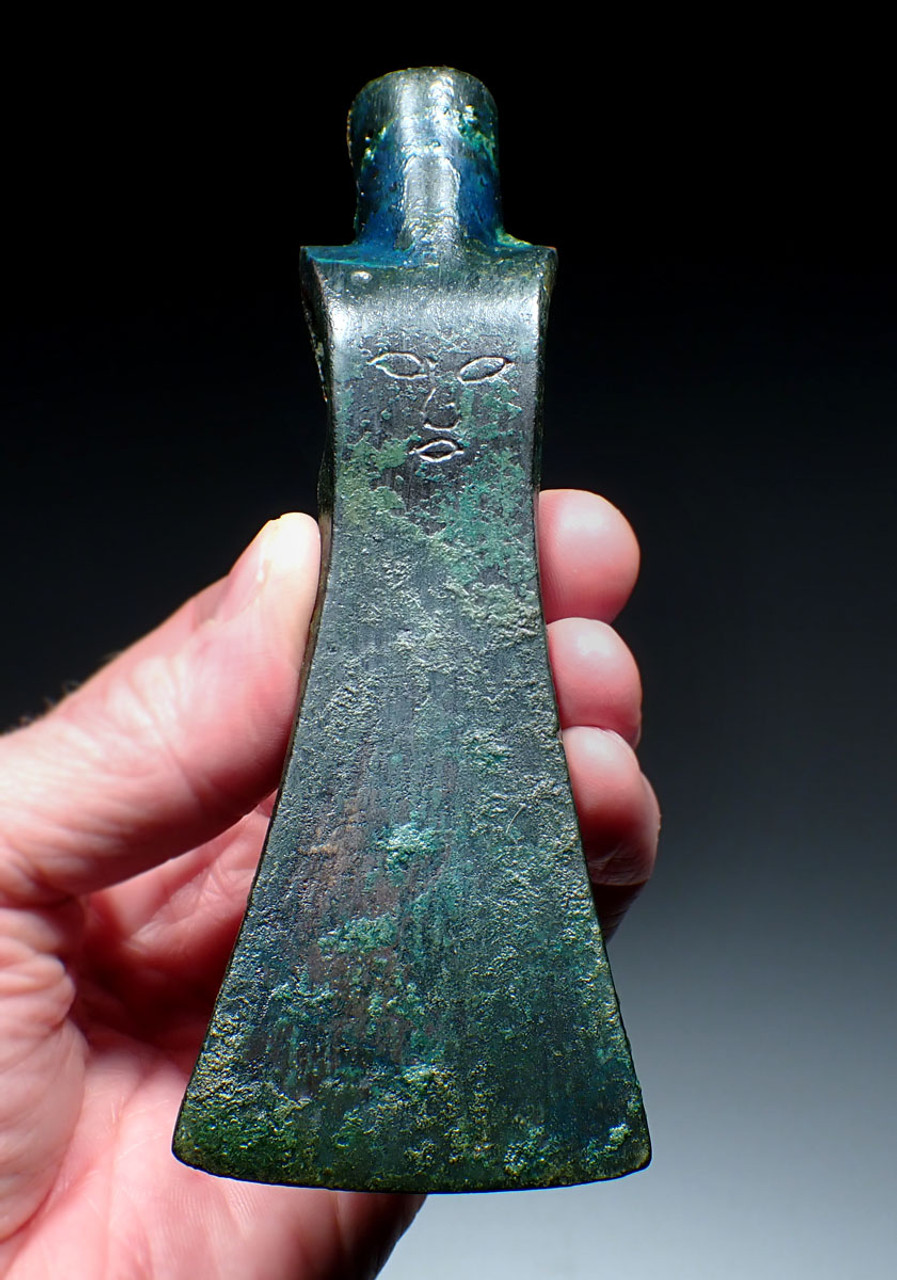Product Description
SEE MORE ANCIENT NEAR EASTERN ARTIFACTS
SEE MORE ANCIENT SCYTHIAN ARTIFACTS
Ancient Saka Indo-Scythian bronze weapons are ULTRA-RARE and their absence in any collection, private or institutional, proves that. This is a unique bronze hammer shaft-hole war axe from the ancient Saka Indo-Scythian Empire. It has a very RARE feature in that a human face has been engraved on BOTH sides of the body of the axe. This engraving is undoubtedly ancient as some of the encrustations are within the recesses of the engraving as seen in the close-up images. Engraving of human facial features is known on some axes from the Luristan culture to the west. Perhaps this was done to impart or honor a spirit in the weapon, or even memorialize a fallen warrior or loved one. It is EXTREMELY RARE and we have seen only a couple instances of such engraving, in our 33 years of experience in this material.
The prominent round hammer peg protruding off the butt end would have made the axe a deadly weapon when struck using either end - one to cut and the other to puncture. The hammer peg on the back end enabled it to penetrate armor and break bones, or pierce a skull. The bronze preservation of this axe is superb, with ample Azurite and Malachite encrustations on all surfaces including within some of the surfaces of the engraving of the facial features.
This artifact has been professionally cleaned and conserved in our lab, being treated with a special sealer developed and formulated by us specifically for ancient metal preservation. The patina shows beautiful traits only found in authentic ancient weapons. It is a patina like this that the finest ancient bronzes are prized for and it is a patina like this that brings a premium in price and value of the specimen. There is no active bronze disease. Bronze disease can develop on ancient bronze that is not properly cleaned and conserved. It produces a corrosive powder that will literally eat away an artifact over time and destroy it.
WARNING: There is a STAGGERING number of fake bronze weapons on the market. Many being sold as "authentic" were never meant to deceive and were made as far back as 100 years ago as exact reproductions for museums to sell in their gift shops. Other examples are modern fabrications specifically intended to fool unwitting buyers. As fine quality intact, original specimens become more scarce, the techniques to fake these objects have become highly advanced. We have personally handled numerous well-done fakes with extremely convincing patinas. The degree to which the fakers have been able to replicate patina to disguise their work requires an expert examination by highly experienced individuals. It is common to find very reasonably priced weapons that are made up of part original and part modern components or wholly modern pieces displaying elaborate artificial patinas. All purchases should include a written guarantee of authenticity from the seller, with unconditional and lifetime return policies regarding such guarantee, such as we provide.
HISTORY
The Saka were a group of nomadic Iranian peoples who historically inhabited the northern and eastern Eurasian Steppe and the Tarim Basin. Though closely related, the Sakas different from the Scythians of the Pontic Steppe and the Massagetae of the Aral Sea region, though they all form part of the wider Scythian cultures. Like the Scythians, the Sakas were ultimately derived from the earlier Andronovo culture. The Sakas were a group of Iranic peoples who spoke a language belonging to the Iranian branch of the Indo-European languages. The Saka were racially Europoid.
Historical records and scientific studies date the Saka as early as the 8th century BC. In the Achaemenid-era,ancient Persian inscriptions found at Persepolis, dated to the reign of Darius I (r. 522-486 BC), record the Saka as having lived just beyond the borders of Sogdia. An inscription dated to the reign of Xerxes I (r. 486-465 BC) has them associated with the Dahae people of Central Asia.
In the 2nd century BC, many Sakas were driven by the Yuezhi from the steppe into Sogdia and Bactria and then to the northwest of the Indian subcontinent, where they were known as the Indo-Scythians. Other Sakas invaded the Parthian Empire, eventually settling in Sistan, while others may have migrated to the Dian Kingdom in Yunnan, China. In the Tarim Basin and Taklamakan Desert region of Northwest China, they settled in Khotan, Yarkand, Kashgar and other places, which were at various times vassals to greater powers, such as Han China and Tang China.
The art of the Saka was of a similar styles as other Iranian peoples of the steppes, which is referred to collectively as Scythian art. Ancient influences from Central Asia became identifiable in China following contacts of metropolitan China with nomadic western and northwestern border territories from the 8th century BC. The Chinese adopted the Scythian-style animal art of the steppes (descriptions of animals locked in combat), particularly the rectangular belt-plaques made of gold or bronze, and created their own versions in jade and steatite.
Following their expulsion by the Yuezhi, some Saka may also have migrated to the area of Yunnan in southern China. Saka warriors could also have served as mercenaries for the various kingdoms of ancient China. Excavations of the prehistoric art of the Dian civilization of Yunnan have revealed hunting scenes of Caucasoid horsemen in Central Asian clothing.
 US DOLLAR
US DOLLAR
 EURO
EURO
 AUSTRALIAN DOLLAR
AUSTRALIAN DOLLAR
 CANADIAN DOLLAR
CANADIAN DOLLAR
 POUND STERLING
POUND STERLING






























